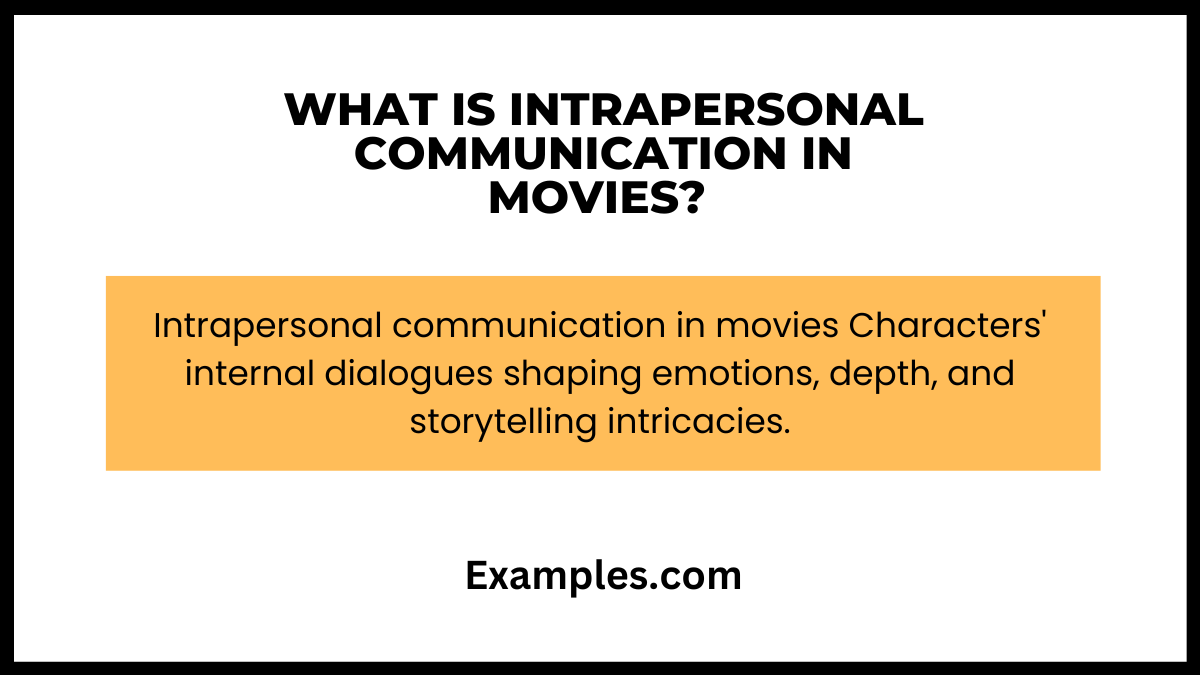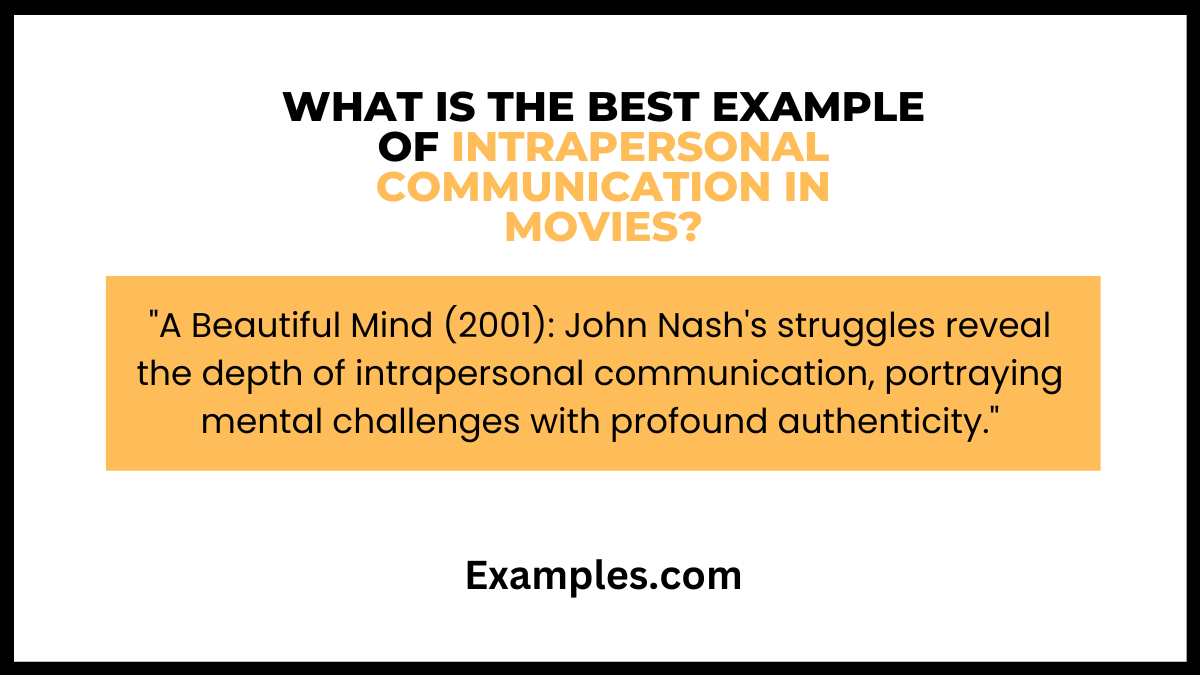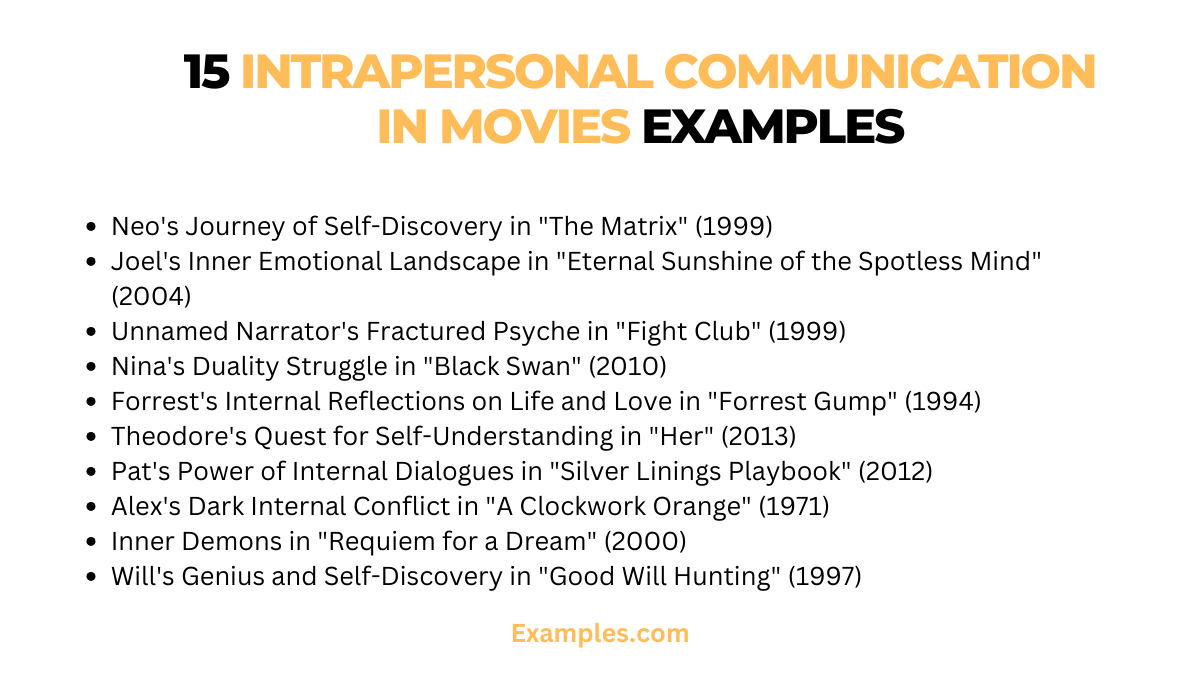14+ Intrapersonal Communication in Movies Examples
Embark on a cinematic journey as we unveil the intricate realm of Intrapersonal Communication in Movies. This comprehensive guide provides illuminating examples that transcend the screen, enriching your understanding of communication. Delve into the art of self-reflection, guided by compelling instances that make every film a lesson in interpersonal dynamics. Elevate your movie-watching experience with this insightful exploration of Intrapersonal Communication, where stories become profound Communication Examples. Unlock the secrets of on-screen dialogue and enhance your personal narrative.
What is Intrapersonal Communication in Movies?

In simple terms, Intrapersonal Communication in movies refers to the internal dialogue and reflection within a character. It’s the silent conversation a character has with themselves, revealing thoughts, emotions, and inner conflicts. This unique form of communication adds depth to storytelling, allowing audiences to connect on a personal level. Intrapersonal Communication in movies is a powerful tool, shaping characters and narratives, making the cinematic experience more relatable and engaging.
What is the Best Example of Intrapersonal Communication in Movies?

One outstanding example of Intrapersonal Communication in movies is showcased in the film “A Beautiful Mind.” The character John Nash, brilliantly portrayed by Russell Crowe, engages in profound internal dialogues as he navigates the challenges of his brilliant yet troubled mind. The audience witnesses Nash’s struggles, fears, and moments of clarity, creating a powerful portrayal of Intrapersonal Communication. The nuanced depiction in this film makes it an exemplary showcase of how cinema can delve deep into the complexities of self-reflection and internal dialogue.
15 Intrapersonal Communication in Movies Examples

- The Matrix (1999): Neo’s internal struggle mirrors his journey of self-discovery.
- Eternal Sunshine of the Spotless Mind (2004): Joel’s memories reflect his inner emotional landscape
- Fight Club (1999): The unnamed narrator’s internal dialogue reflects his fractured psyche, creating a riveting narrative.
- Black Swan (2010): Nina’s internal turmoil unfolds as she grapples with the duality within herself.
- Forrest Gump (1994): Forrest’s simplicity masks profound internal reflections on life and love.
- Her (2013): Theodore’s conversations with an AI mirror his quest for self-understanding.
- Silver Linings Playbook (2012): Pat’s journey unveils the power of internal dialogues in overcoming mental challenges.
- A Clockwork Orange (1971): Alex’s internal conflict reflects the darker aspects of human nature.
- Requiem for a Dream (2000): Characters battle inner demons, portraying the harsh reality of addiction.
- Good Will Hunting (1997): Will’s genius is intertwined with his internal struggles and self-discovery.
- The Truman Show (1998): Truman’s internal questioning challenges the reality presented to him.
- American Psycho (2000): Patrick Bateman’s internal monologues reveal the depths of his disturbed mind.
- Birdman (2014): Riggan Thomson’s internal battles shape the narrative of artistic ambition.
- The Social Network (2010): Mark Zuckerberg’s internal drive propels the creation of Facebook.
- The Shawshank Redemption (1994): Andy Dufresne’s resilience is reflected in his internal reflections on freedom
Intrapersonal Communication in Movies at the Theater
Immerse yourself in the cinematic world, where Intrapersonal Communication takes center stage at the theater. Characters’ internal dialogues come alive, forging a unique bond between the audience and the narrative.
- The Revenant (2015): Hugh Glass’s silent resilience in the wilderness speaks volumes about his internal strength.
- Blade Runner 2049 (2017): K’s contemplative moments amid futuristic landscapes reveal the complexity of his self-discovery.
- The Shape of Water (2017): Elisa’s silent interactions with the Amphibian Man portray a deep, unspoken connection.
- Inception (2010): Cobb’s inner struggles manifest in the surreal landscapes of his dreams, creating a visual representation of his thoughts.
- The Grand Budapest Hotel (2014): Zero’s silent loyalty to M. Gustave showcases a profound connection that goes beyond words.
- Inside Out (2015): Joy and Sadness navigate the emotional landscape within Riley’s mind, showcasing the internal workings of her thoughts.
- The Social Network (2010): Mark Zuckerberg’s contemplative coding moments illustrate the internal drive and focus behind the creation of Facebook.
- Gravity (2013): Dr. Ryan Stone’s isolation in space becomes a metaphor for her internal journey of overcoming fear and finding resilience.
Interpersonal Communication Movie Analysis
Delve into the intricate layers of Interpersonal Communication through cinematic analysis. This exploration transcends mere dialogue, dissecting the subtleties of body language, tone, and relational dynamics. Uncover the art of conveying unspoken emotions, where every glance and gesture paints a vivid picture of human connection.
- Inception (2010): Dom Cobb’s nuanced communication within dreams mirrors complex relationships.
- The Grand Budapest Hotel (2014): The concierge and lobby boy’s dynamic showcases camaraderie through non-verbal cues.
- Hereditary (2018): The family’s strained interactions communicate underlying tensions and secrets.
- The Shape of Water (2017): Elisa and the amphibian creature’s silent connection speaks volumes about acceptance and love.
- Silver Linings Playbook (2012): Pat and Tiffany’s dance sequences portray emotional healing through shared non-verbal communication.
- Eternal Sunshine of the Spotless Mind (2004): Joel and Clementine’s fragmented memories mirror the complexities of human connections.
- The Breakfast Club (1985): The diverse group’s interactions during detention depict the intricacies of teenage communication.
- A Beautiful Mind (2001): John Nash’s struggles showcase how mental health affects interpersonal dynamics
Why is Intrapersonal Communication Important in Movies?
Intrapersonal communication, the internal dialogue within a character, plays a pivotal role in the cinematic landscape, elevating storytelling to profound heights. Understanding the significance of intrapersonal communication in movies is essential for both filmmakers and audiences alike
1. Character Depth: Intrapersonal communication adds layers to characters by exploring their internal thoughts, fears, and desires, making them relatable and compelling.
2. Emotional Resonance: The inner workings of a character’s mind create emotional resonance, deepening viewer connection through shared struggles, joys, and conflicts.
3. Plot Dynamics: Internal dialogues influence plot progression and decision-making, adding complexity and depth to the narrative.
4. Cinematic Artistry: Intrapersonal communication allows filmmakers to showcase artistic prowess through visual cues, symbolism, and subtle expressions, enhancing storytelling.
5. Realism and Authenticity: Accurate depictions of intrapersonal communication provide authenticity, resonating with audiences and intensifying the impact of storytelling.
Intrapersonal communication in movies transcends dialogue, shaping characters and narratives with profound authenticity. From Neo’s self-discovery in “The Matrix” to Pat’s overcoming mental challenges in “Silver Linings Playbook,” these examples showcase the power of internal dialogues. This complete guide illuminates how intrapersonal communication adds depth, emotional resonance, and cinematic artistry to storytelling, creating an immersi and unforgettable viewing experience.
14+ Intrapersonal Communication in Movies Examples

Embark on a cinematic journey as we unveil the intricate realm of Intrapersonal Communication in Movies. This comprehensive guide provides illuminating examples that transcend the screen, enriching your understanding of communication. Delve into the art of self-reflection, guided by compelling instances that make every film a lesson in interpersonal dynamics. Elevate your movie-watching experience with this insightful exploration of Intrapersonal Communication, where stories become profound Communication Examples. Unlock the secrets of on-screen dialogue and enhance your personal narrative.
What is Intrapersonal Communication in Movies?

In simple terms, Intrapersonal Communication in movies refers to the internal dialogue and reflection within a character. It’s the silent conversation a character has with themselves, revealing thoughts, emotions, and inner conflicts. This unique form of communication adds depth to storytelling, allowing audiences to connect on a personal level. Intrapersonal Communication in movies is a powerful tool, shaping characters and narratives, making the cinematic experience more relatable and engaging.
What is the Best Example of Intrapersonal Communication in Movies?

One outstanding example of Intrapersonal Communication in movies is showcased in the film “A Beautiful Mind.” The character John Nash, brilliantly portrayed by Russell Crowe, engages in profound internal dialogues as he navigates the challenges of his brilliant yet troubled mind. The audience witnesses Nash’s struggles, fears, and moments of clarity, creating a powerful portrayal of Intrapersonal Communication. The nuanced depiction in this film makes it an exemplary showcase of how cinema can delve deep into the complexities of self-reflection and internal dialogue.
15 Intrapersonal Communication in Movies Examples

The Matrix (1999): Neo’s internal struggle mirrors his journey of self-discovery.
Eternal Sunshine of the Spotless Mind (2004): Joel’s memories reflect his inner emotional landscape
Fight Club (1999): The unnamed narrator’s internal dialogue reflects his fractured psyche, creating a riveting narrative.
Black Swan (2010): Nina’s internal turmoil unfolds as she grapples with the duality within herself.
Forrest Gump (1994): Forrest’s simplicity masks profound internal reflections on life and love.
Her (2013): Theodore’s conversations with an AI mirror his quest for self-understanding.
Silver Linings Playbook (2012): Pat’s journey unveils the power of internal dialogues in overcoming mental challenges.
A Clockwork Orange (1971): Alex’s internal conflict reflects the darker aspects of human nature.
Requiem for a Dream (2000): Characters battle inner demons, portraying the harsh reality of addiction.
Good Will Hunting (1997): Will’s genius is intertwined with his internal struggles and self-discovery.
The Truman Show (1998): Truman’s internal questioning challenges the reality presented to him.
American Psycho (2000): Patrick Bateman’s internal monologues reveal the depths of his disturbed mind.
Birdman (2014): Riggan Thomson’s internal battles shape the narrative of artistic ambition.
The Social Network (2010): Mark Zuckerberg’s internal drive propels the creation of Facebook.
The Shawshank Redemption (1994): Andy Dufresne’s resilience is reflected in his internal reflections on freedom
Intrapersonal Communication in Movies at the Theater
Immerse yourself in the cinematic world, where Intrapersonal Communication takes center stage at the theater. Characters’ internal dialogues come alive, forging a unique bond between the audience and the narrative.
The Revenant (2015): Hugh Glass’s silent resilience in the wilderness speaks volumes about his internal strength.
Blade Runner 2049 (2017): K’s contemplative moments amid futuristic landscapes reveal the complexity of his self-discovery.
The Shape of Water (2017): Elisa’s silent interactions with the Amphibian Man portray a deep, unspoken connection.
Inception (2010): Cobb’s inner struggles manifest in the surreal landscapes of his dreams, creating a visual representation of his thoughts.
The Grand Budapest Hotel (2014): Zero’s silent loyalty to M. Gustave showcases a profound connection that goes beyond words.
Inside Out (2015): Joy and Sadness navigate the emotional landscape within Riley’s mind, showcasing the internal workings of her thoughts.
The Social Network (2010): Mark Zuckerberg’s contemplative coding moments illustrate the internal drive and focus behind the creation of Facebook.
Gravity (2013): Dr. Ryan Stone’s isolation in space becomes a metaphor for her internal journey of overcoming fear and finding resilience.
Interpersonal Communication Movie Analysis
Delve into the intricate layers of Interpersonal Communication through cinematic analysis. This exploration transcends mere dialogue, dissecting the subtleties of body language, tone, and relational dynamics. Uncover the art of conveying unspoken emotions, where every glance and gesture paints a vivid picture of human connection.
Inception (2010): Dom Cobb’s nuanced communication within dreams mirrors complex relationships.
The Grand Budapest Hotel (2014): The concierge and lobby boy’s dynamic showcases camaraderie through non-verbal cues.
Hereditary (2018): The family’s strained interactions communicate underlying tensions and secrets.
The Shape of Water (2017): Elisa and the amphibian creature’s silent connection speaks volumes about acceptance and love.
Silver Linings Playbook (2012): Pat and Tiffany’s dance sequences portray emotional healing through shared non-verbal communication.
Eternal Sunshine of the Spotless Mind (2004): Joel and Clementine’s fragmented memories mirror the complexities of human connections.
The Breakfast Club (1985): The diverse group’s interactions during detention depict the intricacies of teenage communication.
A Beautiful Mind (2001): John Nash’s struggles showcase how mental health affects interpersonal dynamics
Why is Intrapersonal Communication Important in Movies?
Intrapersonal communication, the internal dialogue within a character, plays a pivotal role in the cinematic landscape, elevating storytelling to profound heights. Understanding the significance of intrapersonal communication in movies is essential for both filmmakers and audiences alike
1. Character Depth: Intrapersonal communication adds layers to characters by exploring their internal thoughts, fears, and desires, making them relatable and compelling.
2. Emotional Resonance: The inner workings of a character’s mind create emotional resonance, deepening viewer connection through shared struggles, joys, and conflicts.
3. Plot Dynamics: Internal dialogues influence plot progression and decision-making, adding complexity and depth to the narrative.
4. Cinematic Artistry: Intrapersonal communication allows filmmakers to showcase artistic prowess through visual cues, symbolism, and subtle expressions, enhancing storytelling.
5. Realism and Authenticity: Accurate depictions of intrapersonal communication provide authenticity, resonating with audiences and intensifying the impact of storytelling.
Intrapersonal communication in movies transcends dialogue, shaping characters and narratives with profound authenticity. From Neo’s self-discovery in “The Matrix” to Pat’s overcoming mental challenges in “Silver Linings Playbook,” these examples showcase the power of internal dialogues. This complete guide illuminates how intrapersonal communication adds depth, emotional resonance, and cinematic artistry to storytelling, creating an immersi and unforgettable viewing experience.


